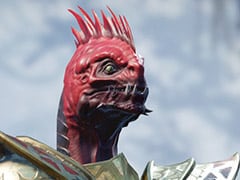Video Gamer is reader-supported. When you buy through links on our site, we may earn an affiliate commission. Prices subject to change. Learn more
Divinity: Original Sin 2 starts off bleakly. Set centuries after the first game, and depicting a society where magic folk are feared, loathed and locked away on island prisons, the first thing it does is shipwreck the player near Fort Joy, a sort of ironically named Alcatraz Hogwarts. ‘But that would be Azkaban’, I hear you cry. Look, shut up.
/https://oimg.videogamer.com/images/6c4d/environment_exploration.jpg)
Larian are rightly very proud of the first game, which I described at the time as “a triumph of the crowdfunding model”. The sequel looks set to repeat that triumph, by refining the first game’s systems, combat, and by expanding the already labyrinthian lore. It too was funded at least in part by a successful Kickstarter campaign, which raised more than twice as much money as the original did.
Before giving an extensive 50-minute demo of the game, Larian asked me what it is I like about RPGs. The RPG audience is a broad church, and no two fans of the genre will agree on what makes them good. It seems to me like a brave question to ask, and a hard one to answer. ‘The story’, though, is the meat of it – a broad term encompassing not just narrative and characters, but the societies these games depict, how they’re built, and how it feels to be an active participant in them. I explain this, and the Larian reps light up, jumping at the chance to tell me that Original Sin 2 has nine writers. Nine times more than the first game had.
Playing the game, it’s not hard to see why so many cooks are needed for the broth. Every interaction, however minor, takes into account your character’s race, demeanour, origin story, things which are chosen by the player at the start. There are five races to choose from, a number of stock characters with detailed background stories, a ‘tag’ system which determines a character’s traits, and how the world perceives them.
It’s a lot to take into account, and Larian seem determined to have every conversation reflect these choices. The demonstration reflects this, showing the same encounters with different parties and player characters. Depending on how you’ve set up your avatar, different conversation options are available, even the tone of NPC responses is noticeably altered from one situation to the next. Just imagining the flow charts required induce a migraine.
/https://oimg.videogamer.com/images/74a6/original_sin_dialogue.jpg)
There are entire questlines that are specific to certain origin stories, and while they will potentially occur no matter what you choose at the start, they will play out differently. They also intertwine, introducing the possibility that two characters in your party will have conflicting goals – an interesting prospect for a single-player campaign, and doubly so when playing in co-op. Playing in tandem with friends with whom your motives do not align sounds fun as hell, if you’re into backstabbing.
The Fort Joy map is enormous, surprisingly so given its effective role as the starting village. As a staging ground for exposition, and a holding pen for party recruitable characters, it feels almost excessive – one wonders how many players will ever see the other parts of the game. (Anecdotally, I know people who played Original Sin for dozens of hours without ever seeing past the first area.)
So, it’s big. There’s a lot of content here that most players will never see, even if they play through the game more than once. Perhaps it’s too big; the prospect of having so much quest content to mine can be intimidating.
“More stuff” isn’t the only change. The turn-based combat system has been rebalanced, with the distribution of action points to expenditure being dramatically altered. The practical result of this is being able to do more per turn. It’s a lot more dynamic than the first game’s stop and start combat, and the system now takes terrain into account, meaning that gaining a height advantage over your enemies is possible. The elemental, er, element is preserved, with cold, heat, electrical and poison spells being able to interact, often with spectacular results.
/https://oimg.videogamer.com/images/318b/original_sin_combat.jpg)
It looks and plays a lot like the first game, but it doesn’t take long to realise that the tenor has changed. There is much more emphasis on player freedom now – not just in the minute to minute gameplay, but in how the player can choose to express themselves and have the world reflect that expression. One stated directive of the design is that if the player doesn’t have a key, they can kick the door in; Larian wants you to solve Original Sin’s 2 problems your way. A tall order, one with a mind-boggling number of permutations.
I hope they pull it off. So far, the results are exciting – the “roleplaying” aspect of RPGs is absurdly neglected in the modern era, so much so that Larian are able to pitch it as their game’s USP in what is a crowded and often misappropriated genre. For that reason alone, Original Sin 2 is well worth keeping an eye on.
